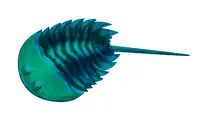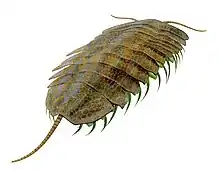Nektaspida
Nektaspida (also called Naraoiida, Nektaspia and Nectaspida) is an extinct order of non-mineralised artiopodan arthropods. They are known from the mid-Cambrian to the upper Silurian. Originally classified as trilobites, which they superficially resemble, they are now placed as close relatives as members of the Trilobitomorpha within Artiopoda. The order is divided into three major families; Emucarididae, Liwiidae, and Naraoiidae.
| Nektaspida Temporal range: | |
|---|---|
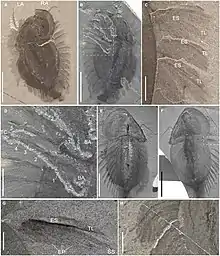 | |
| Naraoia compacta fossils with preserved appendages | |
| Scientific classification | |
| Domain: | Eukaryota |
| Kingdom: | Animalia |
| Phylum: | Arthropoda |
| Subphylum: | †Trilobitomorpha |
| Order: | †Nektaspida Raymond, 1920 |
| Families | |
Naming history and taxonomic placement
The order was originally proposed by Raymond in 1920 as Nektaspia.[1] Størmer corrected it to Nectaspida for the 1959 Treatise on Invertebrate Paleontology to conform with the names of the other trilobite orders. Whittington described it in 1985 with the spelling Nektaspida; the revised 1997 Treatise by Raymond and Fortey uses this spelling, as do other modern works.[2] Whittington (1985) placed the order in the Trilobita. Cotton & Braddy (2000) place it in a new "Trilobite clade" containing the Trilobita, recognizing the close affinities of the nektaspids to trilobites. However this necessitates the inclusion of genera that look very little like trilobites.,[2] it was formerly placed in the stem-group to the chelicerata subdivision of the Arthropoda phylum.[3] However, it currently considered part of Artiopoda, the clade that contains trilobites and their close relatives.[4]
Anatomy
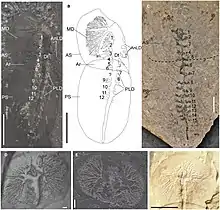
The group is united by several morphological characters, including reduced or absent lateral eyes, a hypostome with a natant attachment, extensive articulation overlap between unfused trunk tergites, and fused pleurae that do not form lateral spines.[5] Preserved soft tissue of the group indicates that the cephalic (head) shield of nektaspids and liwiids contained branched digestive glands.[6] The Naraoiidae have their exoskeletons mostly composed of only two major shields, which have a single articulation point.[7]
Ecology
The naraoiids have been interpreted as benthic organisms that were opportunistic scavengers and predators of soft-bodied prey, with the spine-like endites of the limbs possibly allowing soft-bodied prey to be shredded before ingestion. The differences in gut morphology between some species of naraoiids suggests that some species only intermittently fed, while others regularly fed.[8]
Evolutionary history
The group first appeared and was most diverse in the Cambrian, especially during the Cambrian Series 2. Emucarididae are only known from the Cambrian Series 2 of East Gondwana (now Australia) and the then nearby South China. Naraoiidae were diverse in low latitudes during Cambrian Series 2 and the following Miaolingian in Laurentia and in South China. Liwiidae first appeared in Baltica during the Cambrian, and are absent from major Cambrian deposits elsewhere during this period, but are widespread in the southern high-latitude margin of Gondwana during the Ordovician.[6] The youngest known member of the group is the Laurentian naraoiid Naraoia bertensis from the Bertie Formation in Ontario, Canada, dating to the Upper Silurian.[9]
Gallery
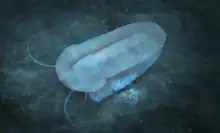 Life restoration of Misszhouia
Life restoration of Misszhouia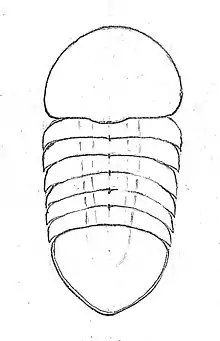 Drawing of the carapace of the incertae sedis nektaspid Buenaspis
Drawing of the carapace of the incertae sedis nektaspid Buenaspis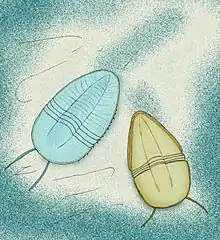 Restoration of the emucaridids Kangacaris (blue, left) and Emucaris (yellow, right)
Restoration of the emucaridids Kangacaris (blue, left) and Emucaris (yellow, right) Fossil of the Ordovician liwiid Tariccoia from Sardinia
Fossil of the Ordovician liwiid Tariccoia from Sardinia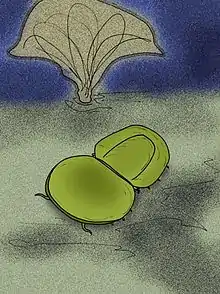 Life restoration of the naraoiid Pseudonaraoia
Life restoration of the naraoiid Pseudonaraoia Fossil of Misszhouia longicaudata
Fossil of Misszhouia longicaudata
References
- Raymond, P.E. (1920). "The appendages, anatomy, and relationships of trilobites". Memoirs of the Connecticut Academy of Arts and Sciences. 7: 1–169.
- Budd, G. E. (1999). "A nektaspid arthropod from the Early Cambrian Sirius Passet fauna, with a description of retrodeformation based on functional morphology". Palaeontology. 42: 99–122. doi:10.1111/1475-4983.00064. S2CID 128566745.
- Budd, G. E.; Jensen, S. (2000). "A critical reappraisal of the fossil record of the bilaterian phyla". Biological Reviews of the Cambridge Philosophical Society. 75 (2): 253–95. doi:10.1111/j.1469-185X.1999.tb00046.x. PMID 10881389. S2CID 39772232.
- Pérez-Peris, Francesc; Laibl, Lukáš; Lustri, Lorenzo; Gueriau, Pierre; Antcliffe, Jonathan B.; Enright, Orla G. Bath; Daley, Allison C. (March 2021). "A new nektaspid euarthropod from the Lower Ordovician strata of Morocco". Geological Magazine. 158 (3): 509–517. doi:10.1017/S001675682000062X. ISSN 0016-7568. S2CID 221859513.
- Mayers, Benjamin; Aria, Cédric; Caron, Jean‐Bernard (January 2019). Zhang, Xi‐Guang (ed.). "Three new naraoiid species from the Burgess Shale, with a morphometric and phylogenetic reinvestigation of Naraoiidae". Palaeontology. 62 (1): 19–50. doi:10.1111/pala.12383. ISSN 0031-0239. S2CID 135331371.
- Pérez-Peris, Francesc; Laibl, Lukáš; Lustri, Lorenzo; Gueriau, Pierre; Antcliffe, Jonathan B; Bath Enright, Orla G; Daley, Allison C (2020-07-10). "A new nektaspid euarthropod from the Lower Ordovician strata of Morocco". Geological Magazine. 158 (3): 509–517. doi:10.1017/s001675682000062x. ISSN 0016-7568. S2CID 221859513.
- Bond, Andrew D.; Edgecombe, Gregory D. (January 2021). Zhang, Xi‐Guang (ed.). "Phylogenetic response of naraoiid arthropods to early–middle Cambrian environmental change". Palaeontology. 64 (1): 161–177. doi:10.1111/pala.12516. ISSN 0031-0239. S2CID 229454194.
- VANNIER, JEAN; CHEN, JUN-YUAN (2007-01-02). "Digestive system and feeding mode in Cambrian naraoiid arthropods". Lethaia. 35 (2): 107–120. doi:10.1111/j.1502-3931.2002.tb00072.x. ISSN 0024-1164.
- Caron, Jean-Bernard; Rudkin, David M.; Milliken, Stuart (November 2004). "A new Late Silurian (Pridolian) naraoiid (Euarthropoda: Nektaspida) from the Bertie Formation of southern Ontario, Canada—delayed fallout from the Cambrian explosion". Journal of Paleontology. 78 (6): 1138–1145. doi:10.1666/0022-3360(2004)078<1138:ANLSPN>2.0.CO;2. ISSN 0022-3360. S2CID 131595361.
External links
- Are Naraoids trilobites?—photographs of specimens and discussion of classification controversy.
- Order Nectaspida—more technical overview with references and descriptions of known genera.


